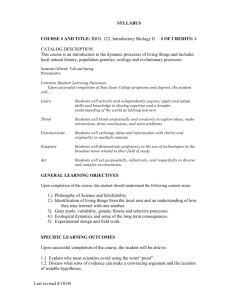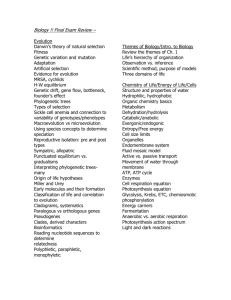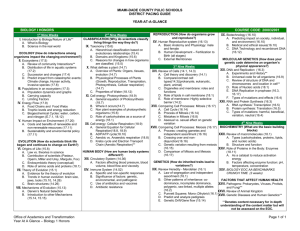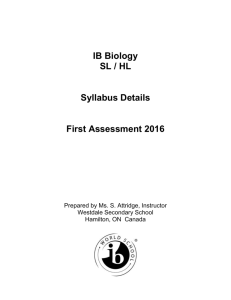BIOL 1406 General Biology I - Wharton County Junior College
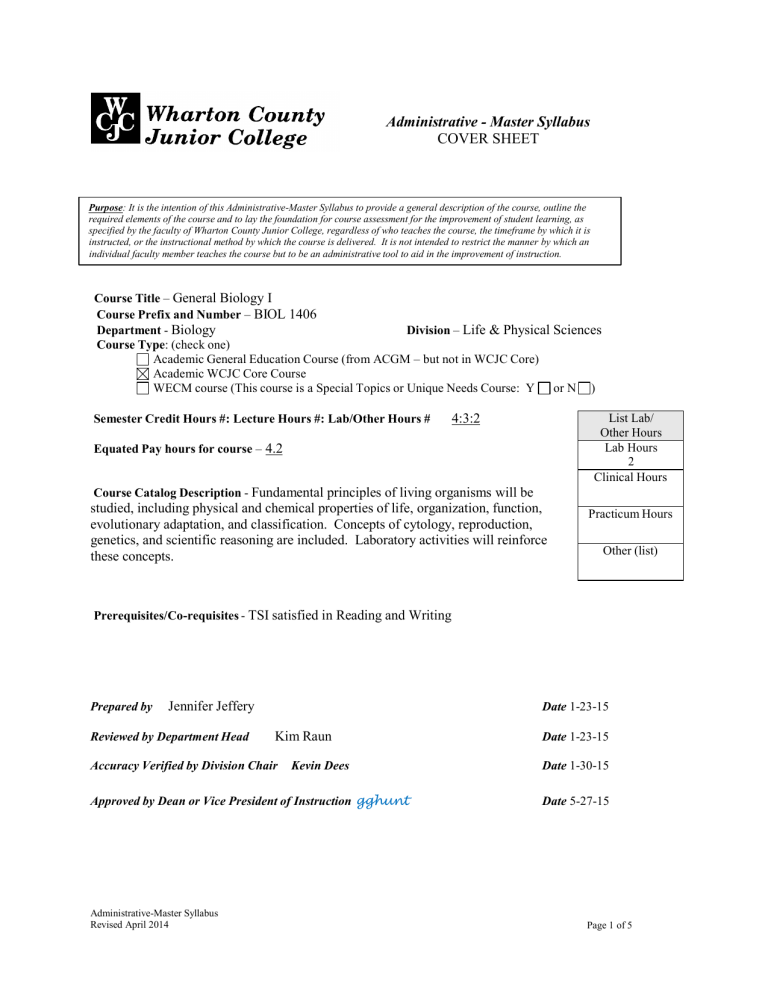
Administrative - Master Syllabus
COVER SHEET
Purpose: It is the intention of this Administrative-Master Syllabus to provide a general description of the course, outline the required elements of the course and to lay the foundation for course assessment for the improvement of student learning, as specified by the faculty of Wharton County Junior College, regardless of who teaches the course, the timeframe by which it is instructed, or the instructional method by which the course is delivered. It is not intended to restrict the manner by which an individual faculty member teaches the course but to be an administrative tool to aid in the improvement of instruction.
Course Title – General Biology I
Course Prefix and Number – BIOL 1406
Department - Biology Division – Life & Physical Sciences
Course Type : (check one)
Academic General Education Course (from ACGM – but not in WCJC Core)
Academic WCJC Core Course
WECM course (This course is a Special Topics or Unique Needs Course: Y or N )
Semester Credit Hours #: Lecture Hours #: Lab/Other Hours # 4:3:2
Equated Pay hours for course – 4.2
List Lab/
Other Hours
Lab Hours
2
Clinical Hours
Course Catalog Description - Fundamental principles of living organisms will be studied, including physical and chemical properties of life, organization, function, evolutionary adaptation, and classification. Concepts of cytology, reproduction, genetics, and scientific reasoning are included. Laboratory activities will reinforce these concepts.
Practicum Hours
Other (list)
Prerequisites/Co-requisites - TSI satisfied in Reading and Writing
Prepared by Jennifer Jeffery Date 1-23-15
Reviewed by Department Head Kim Raun Date 1-23-15
Accuracy Verified by Division Chair Kevin Dees Date 1-30-15
Approved by Dean or Vice President of Instruction
gghunt
Date 5-27-15
Administrative-Master Syllabus
Revised April 2014 Page 1 of 5
Administrative - Master Syllabus
I. Topical Outline – Each offering of this course must include the following topics (be sure to include information regarding lab, practicum, clinical or other non-lecture instruction):
LECTURE TOPICAL OUTLINE
1. Introduction to Biology
A. Characteristics of life
B. Biological organization
C. Introduction to taxonomy
D. Evidence for evolution through natural selection
E. Scientific inquiry and the scientific method
2. Chemistry
A. Atoms and molecules
B. Chemical bonding
C. Importance of water
D. Properties of biological molecules (including structure, function and examples): carbohydrates, lipids, proteins and nucleic acids
3. Viruses
A. Structure and characteristics
B. Reproduction
4. Cells
A. Cell theory
B. Prokaryotic vs. eukaryotic cells (structures, reproduction and characteristics)
C. Membrane structure and function
D. Types of membrane transport (including specific examples of each): passive transport, active transport and bulk transport
5. Energy Flow and Metabolism
A. Laws of thermodynamics
B. Metabolic pathways: catabolic vs. anabolic
C. Structure and hydrolysis of ATP
D. Structure, function and regulation of enzymes
6. Cellular Respiration
A. Cellular respiration as a redox reaction
B. Stages of cellular respiration: glycolysis, citric acid cycle and oxidative phosphorylation
C. Importance and types of fermentation: alcohol vs. lactate
7. Photosynthesis
A. Photosynthesis as a redox reaction
B. Stages of photosynthesis: light reactions and the Calvin cycle
Administrative-Master Syllabus
Revised April 2014 Page 2 of 5
8. The Cell Cycle
A. Importance (roles) of cell division
B. Mitotic cell cycle: interphase, mitotic phases and cytokinesis
C. Cell cycle regulation
9. Meiosis and Sexual Life Cycles
A. Importance (role) of meiosis in sexual life cycles
B. Meiotic stages: meiosis I vs. meiosis II
C. Contribution of genetic variation to evolution
10. Classical Genetics
A. Mendel’s laws of segregation and independent assortment
B. Monohybrid and dihybrid crosses
C. Mendelian patterns of inheritance in humans
D. Extending Mendelian genetics: codominance, incomplete dominance, multiple alleles, pleiotropy, epistasis, polygenic inheritance and sex-linked genes
11. DNA Replication
A. Discovering DNA structure: Watson, Crick and Franklin
B. Semiconservative model of replication
C. Proteins involved in DNA replication and repair
D. Steps of replication process for leading and lagging strands
12. Protein Synthesis
A. Flow of genetic information: DNA
RNA
protein
B. Steps of transcription and translation
C. Point mutations and their effect on protein structure and function
LAB TOPICAL OUTLINE
1. Orientation, laboratory safety and the microscope
2. Properties of water, electrolytes, acids & bases
3. Biological molecules
4. Cell structure and function
5. Movement of molecules
6. Enzymes
(Lab practical #1)
7. Cellular respiration and alcohol fermentation
8. Photosynthesis
9. The cell cycle
10. DNA structure, function and extraction
11. DNA fingerprinting I
12. DNA fingerprinting II and protein synthesis
(Lab practical #2)
Administrative-Master Syllabus
Revised April 2014 Page 3 of 5
II. Course Learning Outcomes
Learning Outcomes
Upon successful completion of this course, students will:
1. Describe the characteristics of life.
2. Explain the methods of inquiry used by scientists.
3. Identify the basic requirements of life and the properties of the major molecules needed for life.
4. Compare and contrast the structures, reproduction, and characteristics of viruses, prokaryotic cells, and eukaryotic cells.
5. Describe the structure of cell membranes and the movement of molecules across a membrane.
6. Identify the substrates, products, and important chemical pathways in metabolism.
7. Identify the principles of inheritance and solve classical genetic problems.
8. Identify the chemical structures, synthesis, and regulation of nucleic acids and proteins.
9. Describe the unity and diversity of life and the evidence for evolution through natural selection.
10. Apply scientific reasoning to investigate questions and utilize scientific tools such as microscopes and laboratory equipment to collect and analyze data.
11. Use critical thinking and scientific problem-solving to make informed decisions in the laboratory.
12. Communicate effectively the results of scientific investigations.
Methods of Assessment
Exams, lab reports, essays, presentations, discussions (online or in- class), group activities, graph/table/chart presentations or post-tests
Administrative-Master Syllabus
Revised April 2014 Page 4 of 5
III. Required Text(s), Optional Text(s) and/or Materials to be Supplied by Student.
Text: Reece, et al. Campbell Biology . Pearson. Current edition
Lab Manual: Crowder, Durant and Penrod. Exploring the Unity of Organisms: Biology 1
Laboratory Manual . Hayden-McNeil. Current edition.
IV. Suggested Course Maximum – 36 lecture; 24 lab
V. List any specific spatial or physical requirements beyond a typical classroom required to teach the course .
Laboratory classroom required
VI. Course Requirements/Grading System – Describe any course specific requirements such as research papers or reading assignments and the generalized grading format for the course
Lecture Average:
Exam average (3-4 exams)
Other (homework, quizzes, projects, etc.)
Laboratory Average*
55%
30-55%
0-25%
25%
A
B
C
D
F
100-90
89-80
79-70
69-60
Below 60
Final Exam (includes at least 50% comprehensive material) 20%
Total 100%
*Laboratory Average calculated as follows:
Quiz Average (best 6 of 9 weekly quizzes)
Lab Practical #1 Exam
Lab Practical #2 Exam
50%
25%
25%
VII. Curriculum Checklist
- Academic General Education Course (from ACGM – but not in WCJC Core)
No additional documentation needed
- Academic WCJC Core Course
Attach the Core Curriculum Review Forms
•
Critical Thinking
•
•
•
•
•
Communication
Empirical & Quantitative Skills
Teamwork
Social Responsibility
Personal Responsibility
- WECM Courses
If needed, revise the Program SCANS Matrix & Competencies Checklist.
Administrative-Master Syllabus
Revised April 2014 Page 5 of 5



